Imagine a future where plug-in cars not only know when the cheapest time to charge is, but also work in concert with utility companies to recharge when it is greenest or when grid power demand is the lowest.
For years, automakers, charging station manufacturers, utility companies and even the U.S. military have been working to make that a reality, but as yet smart grid technology isn’t a reality for the average U.S. electric car driver.
The reason, according to General Motors, is simple: utility companies just aren’t ready yet.
Concept already proven
Earlier this year, GM demonstrated its own smart-grid software as part of a joint project with Google and PJM, an independent, regional transmission organization (RTO) responsible for the upkeep, wholesale, and transmission of electricity using the high-voltage utility grid.
2013 Chevrolet Volt
Using data provided by PJM, GM was able to control when the Google fleet of 25 Chevrolet Volts charged using its OnStar software.
“We took a renewable energy signal that PJM has created,” explained Paul Pebbles, Business Service Manager for Fleet - Volt at OnStar. “We were able to show, with a high level of confidence, that we could actually control the charging of the Volts to match that renewable energy signal.”
Car is ready, utilities aren’t
When asked if any of the smart grid features it tested in the project would make it into the 2014 Volt, Pebbles was brutally honest.
“The vehicle is ready. OnStar is ready,” he said. “We’re working to get the utilities and some of the energy companies to sign up and be part of this from more than just a demonstration perspective.”
A long, complicated process
While GM reports making good progress from initial discussions with utility companies, the reality of implementing smart grid technology takes a long time.
As Pebbles explained, after an initial recognition of the technology, utility companies have to work with the public utility commission to gain approval for a smart grid pilot project.
After the successful end of a pilot project, the utility company must then carry out a twelve-month test with paying customers, followed by a further wait of between 6 to 8 months before it can be offered as a permanent service to customers.
The process is further complicated by the 3,500 or so public and private utility companies in the U.S. and Canada.
Better Place is different
Renault Fluence ZE charging at Better Place charge point in apartment bldg [photo: Brian of London]![Renault Fluence ZE charging at Better Place charge point in apartment bldg [photo: Brian of London] Renault Fluence ZE charging at Better Place charge point in apartment bldg [photo: Brian of London]](https://images.hgmsites.net/lrg/better-place-photo-brian-of-london_100393065_l.jpg)
The astute reader will note that some of these smart-grid features are already in place in Israel, operating as part of Better Place’s nationwide electric car network.
That’s because of two reasons.
First, Israel is a relatively small nation.
Second, Israel only has one main utility company, making the implementation of smart grid technology far simpler.
It’s coming...slowly
The message from GM is clear: it wants to build future versions of the Chevrolet Volt -- and any future all-electric plug-in cars -- with smart grid technology built into the OnStar system.
And because most of the technology needed is software-based rather than hardware based, GM can roll out the technology as utility companies add smart grid capabilities.
At some point in the future, GM says, owners of plug-in cars with domestic photovoltaic solar panels may even be able to set up a charging behavior that only recharges their car when excess solar power is being generated.
How long it takes for those features to be offered however depends on one thing: how quickly U.S. utility companies can implement smart grid technology.
+++++++++++













